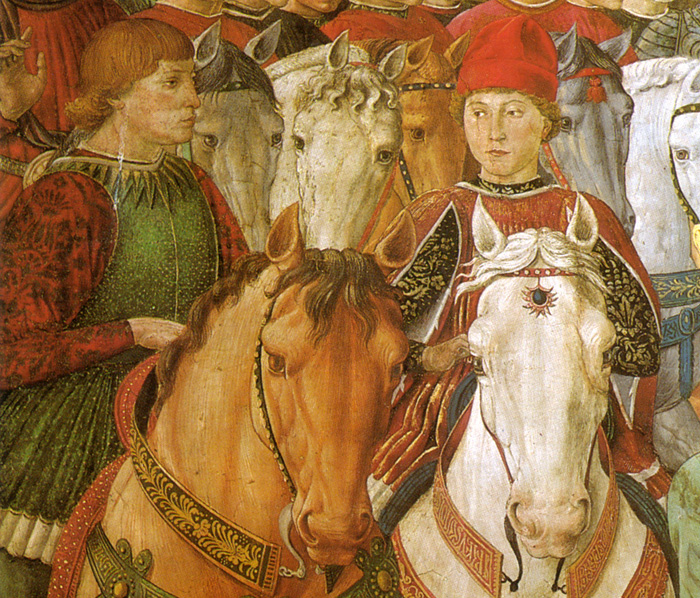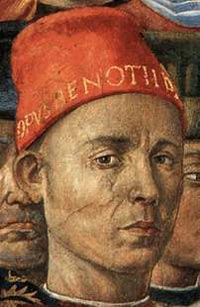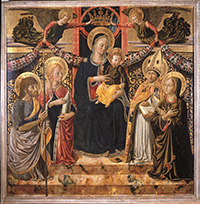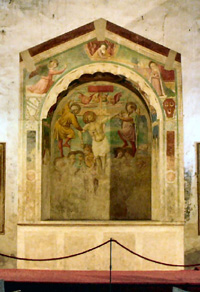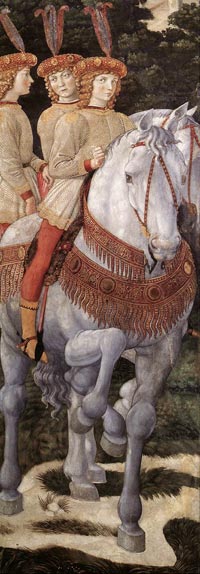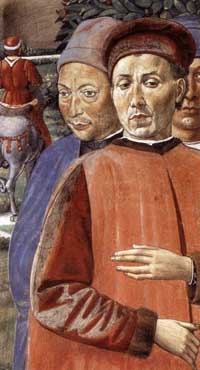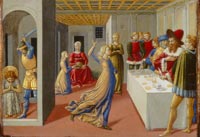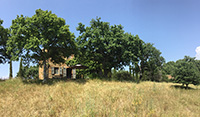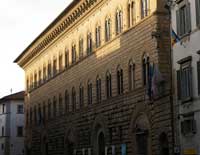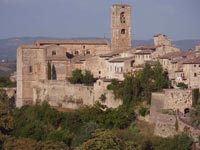Benozzo Gozzoli
|
Benozzo Gozzoli (c. 1421 – 1497) was an Italian Renaissance painter from Florence. He is best known for a series of murals in the Palazzo Medici-Riccardi depicting festive, vibrant processions with wonderful attention to detail and a pronounced International Gothic influence. Gozzoli's formative collaborations included those with Lorenzo and Vittorio Ghiberti on the third bronze door of the Baptistery, Florence (1444), with Fra Angelico [1] on the pictorial decoration of the Dominican convent of San Marco in Florence (1444-45), with Fra Angelico on some frescoes in the chapel of Pope Nicholas V in the Vatican (1447), and again with Fra Angelico on the ceiling of the Chapel of San Brizio in the cathedral at Orvieto (1448). |
||
| Soon afterwards he returned to his native city Florence, the epicenter of Quattrocento art. Between 1459 and 1461, Gozzoli painted what may be considered his most important work: his frescoes of the Magi in the Magi Chapel of the Palazzo Medici-Riccardi, the Journey of the Magi to Bethlehem, and in the tribune, a composition of Angels in Paradise. Gozzoli incorporated portraits of the Medici family into his fresco The Journey of the Magi. Gozzoli also included his self-portrait in the procession, with his name written around the rim of his cap. His Virgin and Child with Saints of 1461, in the National Gallery, London, belongs also to the period of this stay in Florence. Upon his return to Florence in 1459, he began his famous Journey of the Magi for the chapel in the Medici Palace. There he painted a magnificent cavalcade of pilgrims to Bethlehem, including animated portraits of contemporary Florentines. To represent the Magi he painted Lorenzo de' Medici and two leaders of the East, Patriarch Joseph and Emperor John Paleologus. Gozzoli depicted them in exotic Middle Eastern dress against a background of fantastic landscape and strange animals. In 1464 Gozzoli left Florence for San Gimignano, where he executed some extensive works; in the church of Sant'Agostino, a composition of St. Sebastian protecting the City from the Plague of this same year, 1464; over the entire choir of the church, a triple course of scenes from the legends of St Augustine, from the time of his entering the school of Tegaste on to his burial, seventeen chief subjects, with some accessories; in the Pieve di San Gimignano, the Martyrdom of Sebastian, and other subjects, and some further works in the city and its vicinity. Here his style combined something of Filippo Lippi with its original elements, and he received co-operation from Giusto d'Andrea. From 1464 to 1465, Benozzo resided in Certaldo, a small town in the heart of the Elsa Valley, near San Gimignano. The San Tommaso and Prospero church (Church of St. Thomas and Prosper), next to Palazzo Pertorio, houses the most important work, The Tabernacle of the Executed (c. 1464/65), a fresco by Benozzo Gozzoli. Originally, this work was located in the plain, near the Agliena stream: those sentenced to death, before their execution, were brought near this frescoed chapel (The Tabernacle of the Executed), where they received the last solace. The chapel is still visible under the bridge, on the right side coming from Poggibonsi. He stayed in San Gimignano till 1467, and in 1469 began the vast series of mural paintings in the Campo Santo of Pisa with which his name is specially identified. There are twenty-four subjects from the Old Testament, from the Invention of Wine by Noah to the Visit of the Queen of Sheba to Solomon. He contracted to paint three subjects per year for about ten ducats each. It appears, however, that this contract was not strictly adhered to, for the actual rate of painting was only three pictures in two years. Perhaps the great multitude of figures and accessories was accepted as a set-off against the slower rate of production. By January 1470 he had executed the fresco of Noah and his Family, followed by the Curse of Ham, the Building of the Tower of Babel (which contains portraits of Cosimo de' Medici, the young Lorenzo, Angelo Poliziano and others), the Destruction of Sodom, the Victory of Abraham, the Marriages of Rebecca and of Rachel, the Life of Moses, etc. In the Cappella Ammannati, facing a gate of the Campo Santo, he painted also an Adoration of the Magi, wherein appears a portrait of himself. In 1478 the Pisan authorities had given him, as a token of their regard, a tomb in the Campo Santo. Benozzo Gozzoli | The Vintage and Drunkenness of Noah and other frescoes in Pisa
|
|
|
Procession of the Magi in the Palazzo Medici-Riccardi in Florence (1459-60) |
||
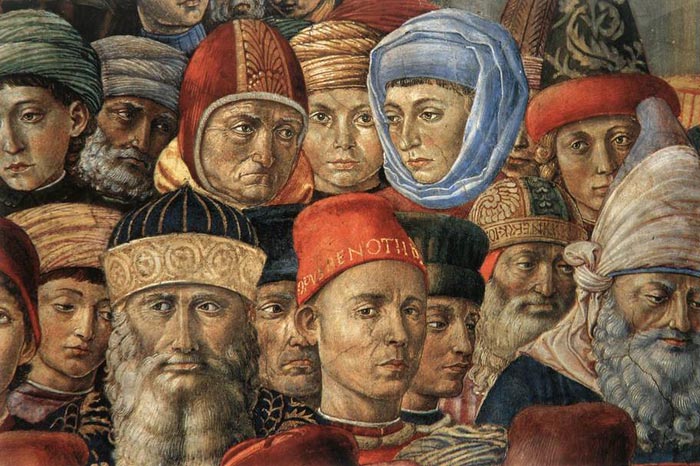 |
||
| Benozzo Gozzoli, Procession of the Magi (detail), 1459-60, Palazzo Medici-Riccardi, Firenze
|
||
| Piero il Gottoso (the Gouty), who was responsible for furnishing the new palace on Via Larga in Florence, decided to engage Benozzo Gozzoli to paint the private chapel, trusting in the artist’s extraordinary talent to depict a vivid variety of subjects with an equally realistic rendering of portraits, clothing and landscapes. In 1459, therefore, he created the frescoes of the world-famous Procession of the Magi, in which the sumptuous procession of the three kings is illustrated against a backdrop of richly detailed landscapes with a fairytale air, seeming to increase the size of the small chapel. In reality, this Evangelical episode was merely a pretext for the commissioners’ desire to celebrate the power and wealth of the Medici family, effectively emphasised by the opulence of the robes, in a setting which undoubtedly served a dual purpose as a place of worship and a venue for small private audiences. This commission, still considered Benozzo’s greatest masterpiece, demonstrates the artist’s rise to the status of one of the powerful Medici family’s most trusted painters. The Magi Chapel, a chapel in Palazzo Medici Riccardi of Florence, includes a famous cycle of frescoes by Benozzo Gozzoli, painted in 1459-1461. The chapel is on the piano nobile of the palace, and was one of the first decorations executed after the completion of the edifice by Michelozzo. Gozzoli painted his cycle over three of the walls, the subject being the Journey of the Magi to Bethlehem, but the religious theme was a pretext to depict the procession of important people who arrived in Florence in occasion of the Council of Florence (1438-1439). In this occasion the Medici could boast to have favoured the reconciliation between the Catholic and the Byzantine churches. The luxury of the Byzantine dignitaries is manifest, and shows the impression they would have at the time on the Florentine population. Over a rich landscape probably influenced by Flemish artists (perhaps through tapestries), Gozzoli portrayed the members of the Medici family riding in the foreground of the fresco on the wall at the right of the altar. A young Lorenzo il Magnifico leads the procession on a white horse, followed by his father Piero the Gouty and the family founder, Cosimo. Then come Sigismondo Pandolfo Malatesta and Galeazzo Maria Sforza, respectively lord of Rimini and Milan: they did not take part in the Council, but were guests of the Medici in Florence in the time the frescoes were painted. After them is a procession of illustrious Florentines, such as the humanists Marsilio Ficino and the Pulci brothers, the members of the Art Guilds and Benozzo himself. Most of the figures in the Procession of the Magi were painted from live models and given the likeness of Benozzo Gozzoli's contemporaries. The painter tried to represent as many likeness as possible, often without concern for the actual space taken up by the body. Only a few figures enjoy sufficient space. The painter can be recognized for he is looking towards the observer and for the scroll on his red hat, reading Opus Benotii. Art in Tuscany | Benozzo Gozzoli, Procession of the Magi in the Palazzo Medici-Riccardi in Florence |
||||
|
||||
| Although, due to the strictly private nature of the little chapel, these frescoes could not be seen by many of his contemporaries, Benozzo earned great fame for them and received commissions for important panel paintings. These included the Madonna and Child with nine angels (Detroit Museum), the pillar frescoed with three Saints within gilded panels (Accademia Gallery in Florence) and the altarpiece for the Confraternity of the Purification in Florence, originally housed in some of the rooms in the Convent of San Marco (Saint Mark). In the contract relating to this work, the clients explicitly requested that the artist use the same style as the altarpiece painted by Fra Angelico (Angelic Friar) for the church of that Convent. Benozzo’s altarpiece, now housed in the National Gallery in London, was adorned with altar-step panels, now divided among various museums around the world. The painter received a further commission for a prestigious work from the wealthy Alessandri family who wished him to "improve" the fourteenth-century polyptych by Lippo di Benivieni in the Church of San Pier Maggiore in other words modernise the ancient painting according to the tastes of the day. Of Benozzo’s part in this work, the four small altar-step panels illustrating the Stories of the Saints depicted in the main panel still survive and are housed in the Metropolitan Museum in New York. Other works he produced during this period include the altar-step housed in the San Marco (Saint Mark) Museum which must have been part of a still unidentified altarpiece. |
||||
During his career, Benozzo had engaged various times in the decoration of tabernacle/oratory monuments (in Certaldo and Legoli). However, the two most significant examples, in terms of their situation on main roads used by travellers and pilgrims and their size and commission, were perhaps the ones he frescoed in Castelfiorentino, both commissioned by the prior of Castelnuovo, Messer Grazia di Francesco, one in 1484, dedicated to the Madonna of the Cough, and the other in 1490-1491, created in collaboration with his sons, Francesco and Alesso, usually known as the Madonna of the Visitation.
|
||||
 |
||||
Benozzo Gozzoli, Tabernacolo della Madonna della Tosse (Castelfiorentino)
|
||||
| In 1484, after his experience in Pisa, Benozzo, with the help of his studio, frescoed the tabernacle on the road from Castelfiorentino to Castelnuovo d'Elsa with the Dormition of the Virgin, which came to be known as the Madonna of the Cough as a result of the constant devotion of the local people to this chapel.
Indeed, whooping cough, pertussis or "tosse cattiva" (bad cough), as it was called in Tuscany, was a very common illness until a few years ago, mainly affecting children and causing a violent, barking cough. This was not only bothersome but could become fatal, and it was therefore customary among the faithful to erect shrines dedicated to the Virgin Mary, where mothers would accompany children suffering from the epidemic. Some of the most important examples are the tabernacle built in the early sixteenth century in Florence, near San Gallo Gate, and transformed into an oratory in 1595 by the Grand Duchess Cristina di Lorena following the grace granted to her own children. The fresco within a clypeus on the cross-vaulted ceiling of the Tabernacle of the Madonna of the Cough depicts a Jesus in the act of blessing, while those on the webs depict the four Apostles with their customary iconographic attributes: Mark with the lion, Luke with the ox, Matthew with the angel and John with the eagle. Frescoed on the central wall is a sophisticated and effective trompe l'oeil altarpiece, with five angels pulling back the cloth to reveal the Virgin and Child enthroned surrounded by Saints Peter, Catherine of Alexandria, Margaret and Paul. In an asymmetrical position in front of the main scene, there is a small icon with an effigy of the Holy Face which, thanks to the illusionistic effect, appears casually placed on the trompe l'oeil altar-step. A period photo documenting the frescoes before their removal illustrates the stone altar that was placed against the wall, highlighting how this image simulated the fixtures of a real religious altar made ready for Holy Mass.
|
||||
| The scene of the Funeral of the Virgin occupies the right-hand wall. Participating in this holy event is Messer Grazia of Castelnuovo, the work's commissioner, kneeling in the foreground. The fresco on the left-hand wall depicts the Assumption of the Virgin to Heaven, interpreted according to the Golden Legend by Jacopo da Varagine (+ 1298), showing the Madonna that throws the belt to Saint Thomas, the twelfth Apostle who doubted the Resurrection of Christ. The image of the Virgin Mary, ascending to Heaven and throwing her belt down to the Apostle Thomas appears in many paintings and sculptures, for example in the images of the Assumption by Agnolo Gaddi in the Cathedral of St. Stephen (Prato, Tuscany), Andrea Orcagna in Orsanmichele (Florence), Ghirlandaio in Santa Maria Novella (Florence) and Pinturicchio in Santa Maria del Popolo (Rome) and in various terracotta works by Della Robbia (in Foiano and La Verna in the Province of Arezzo). It may be noted that this episode was depicted almost exclusively by Italian artists, which is not surprising since Prato boasted and continues to boast the relic of the belt which, according to legend, came from Palestine. In reality, it probably came from Constantinople where it was greatly revered before being brought to Italy.
|
 |
|||
Despite the high quality of these frescoes, critics believe it to be the fruit of collaboration by Benozzo's studio and particularly his son, Francesco. The contribution of his sons, Alesso and Francesco, was explicitly cited, on the other hand, in a lost inscription on the Tabernacle of the Visitation. In 1853, the Tabernacle of the Madonna of the Cough was encased in a neo-Gothic chapel, transforming it into an oratory, in order to preserve it. This solution did not, however, prevent the decay of the frescoes caused by the high humidity levels. In 1970, the authorities responsible for their protection therefore deemed it opportune to remove them from the walls and carry out careful restoration. Indeed, a thick layer of limescale had formed over the frescoes and, particularly in the lower areas, the humidity had resulted in sulphation of the plasterwork, a chemical process which causes a reaction in the calcium carbonate (the main element of which frescoes consist), forming calcium sulphate, commonly known as gypsum. This phenomenon can cause the frescoes to become "dusty", i.e. lose their pigment if touched, or, if the plaster is compact and non-porous, the gypsum can form bubbles which later burst. The restoration work consisted, above all, of making good the raised and dusty areas of colour, after which the frescoes were affixed to a fibreglass backing and carefully cleaned using ammonium carbonate (a salt also contained in baking powder) and distilled water Of course, the colours that the artist had applied "dry" were entirely lost. In the areas of the frescoes containing gaps, it was decided to carry out pictorial restoration with a "neutral shade". Since it was impossible to return the work to its original site (as a small stream runs under the chapel causing excessive dampness), it remained in storage in the Florentine Fine Art Superintendence until 1987, when it was decided that the frescoes should be exhibited in the Municipal Library in Castelfiorentino. While this arrangement allowed Benozzo Gozzoli's work, previously hidden from view, to be admired, it also prevented the tabernacle from being reconstructed in its entirety. Indeed, the chosen venue prevented the display of the painted imitation marble skirting which adorned the lower register. From January 2009, however, this tabernacle, together with the Tabernacle of the Visitation, will be more suitably placed in the new venue, the Benozzo Gozzoli Museum, especially designed to house these magnificent pieces of architecture. The frescoes of both tabernacles have been restored for the occasion. In the small oratory on the road from Castelfiorentino to Castelnuovo, the original site of the frescoes of the Madonna of the Cough, the sinopia (preparatory drawing) of the scene depicting the Virgin and Child enthroned was discovered, traces of which were also visible in the photographs taken during the removal of the frescoes. This discovery once again confirms Benozzo's regular use of the sinopia technique for the preparatory drawings of his works, and disproves what scholars had conjectured, namely that Gozzoli would prepare the drawings on cardboard and then entrust them to his close collaborators to copy out using the "spolvero" (dusting) technique for the painting of the frescoes. Serena Nocentini
|
||||
Fresco cycle in the Convento di San Fortunato in Montefalco (1450-52) |
||||
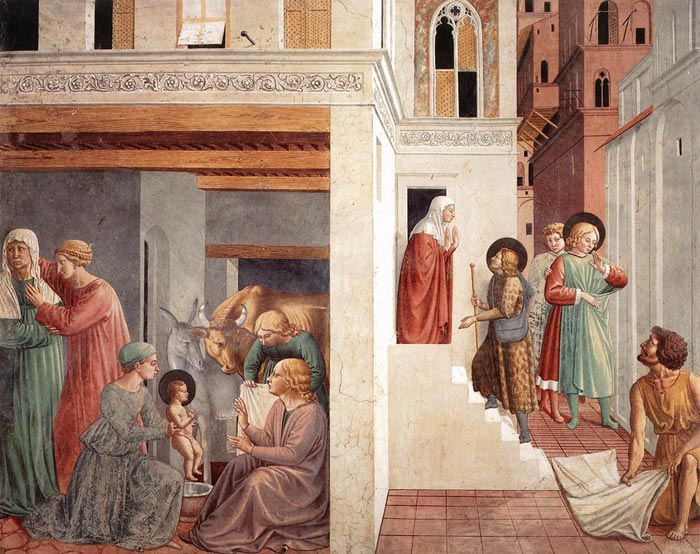 |
||||
Scenes from the Life of St Francis (Scene 1, north wall), 1452, fresco, 304 x 220 cm, Apsidal chapel, San Francesco, Montefalco |
||||
Fresco cycle in the apsidal chapel of Sant'Agostino, San Gimignano |
||||
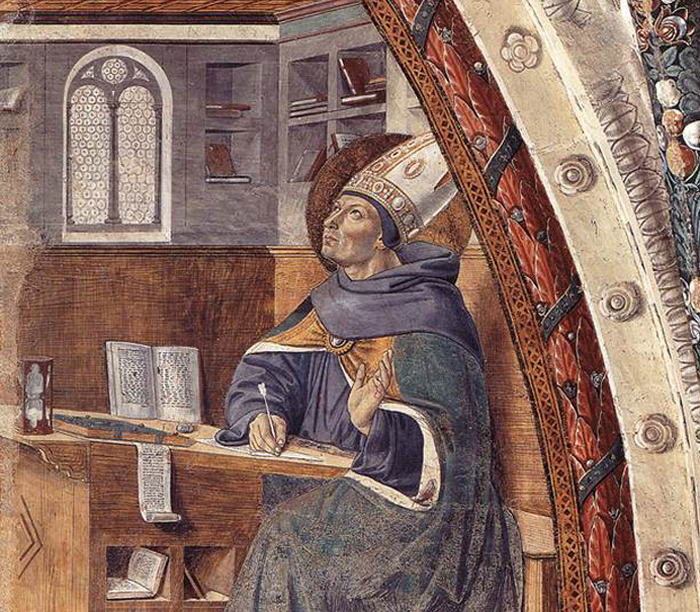 |
||||
St Augustine's Vision of St Jerome (scene 16, 1464-65, fresco, Apsidal chapel, Sant'Agostino, San Gimignano |
||||
By 1463 Benozzo Gozzoli was working at San Gimignano on a cycle of 17 scenes from the life of St Augustine in the choir of Sant'Agostino (last scene signed and dated 1465) and on a fresco of St Sebastian (1464). Benozzo Gozzoli | Fresco cycle in the apsidal chapel of Sant'Agostino, San Gimignano Sant'Agostino |
||||
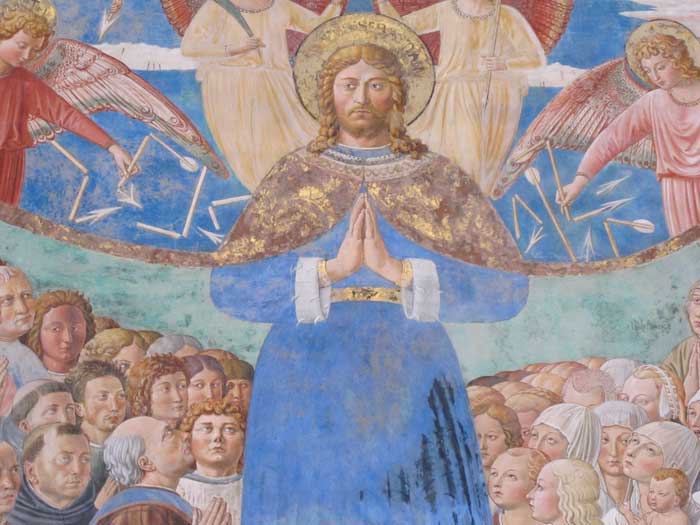 |
||||
Benozzo Gozzoli, Saint Sebastian, 1464-1465, fresco (detail), San Gimignano, San’Agostino |
||||
 |
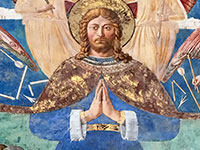 |
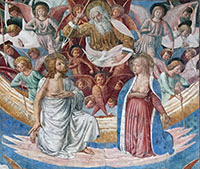 |
||
Benozzo Gozzoli, San Sebastiano (particolare), 1464, chiesa di Sant'Agostino, San Gimignano
|
||||
| The Feast of Herod and the Beheading of Saint John the Baptist, 1461-1462 |
||||
| A contract for an altarpiece, executed between the artist and the Confraternity of the Purification of the Virgin, gives explicit instructions. The artist "is obligated to apply himself to this painting so that the said picture will excel, or at least favorably compare with, every good picture made thus far by [him]." The appearance of the central section is carefully prescribed: the Virgin is to be flanked by John the Baptist and five other named saints "with all the usual attributes." Gozzoli must also "with his own hand...paint at the bottom, that is in the predella...the stories of said saints."
This is one of those predella panels. And here Gozzoli had the freedom to exercise his particular skill as a storyteller. In this one small painting he has packed three episodes related in Matthew 14:6–8. At the center of the painting, we see the twirling figure of Salome, dancing to entertain Herod and his guests, all of whom wear fifteenth-century finery. Herod was so enchanted that he promised Salome whatever she might ask, and prompted by her mother, who sought revenge against John, Salome's request was bloody: "Give me the head of John the Baptist." There inside an archway at left, the saint kneels to be beheaded. And at the rear Salome presents the severed head to her mother. |
||||
[2] According to the 1911 Encyclopædia Britannica, "Gozzoli's art does not rival that of his greatest contemporaries, either in elevation or in strength, but it is attractive because of its sense of what is rich, lively and abundant in the appearances of people and objects. His landscapes, which are crowded with birds and animals, especially dogs, are more varied, and alluring than those of any predecessor; his compositions are crowded with figures, more characteristically true when happily and gracefully occupied than when the demands of the subject require tragic or dramatic intensity, or turmoil of action; his colours are bright and festive. Gozzoli's genius was, on the whole, more versatile and referential than particularly original; his drawings exhibited some imperfections, especially towards the edges, and in his draftsmanship, and in the perspective of his elaborate buildings. In fresco-painting he used the technique of tempera. Of his untiring industry, the intensity of his work and the number of paintings produced are the most convincing proof... In rectitude of life he is said to have been worthy of his first master, Fra Angelico." [3] The four panels in The Metropolitan Museum of Art, New York, were painted for the Alessandri family — the same family that commissioned the altarpiece by Fra Filippo Lippi displayed in this gallery — as the predella to their altarpiece in the church of San Pier Maggiore, Florence. The altarpiece was by the fourteenth-century painter Lippo di Benivieni, and Gozzoli's predella was part of a remodernization that also entailed putting a new, Renaissance-style frame on the old Gothic polyptych.
|
||||
Castelfiorentino | www.museobenozzogozzoli.it
|
||||
|
||||
Podere Santa Pia |
Podere Santa Pia, giardino |
Podere Santa Pia
|
||
Palazzo Medici Riccardi, Florence |
Colle di Val d'Elsa
|
Florence, Duomo |
||
 |
 |
 |
||
San Gimignano |
Chiesa di Sant’Agostino a San Gimignano, interno
|
Benozzo Gozzoli, Pala di Sant’Andrea, Madonno col Bombino e due ongeli tra I sonti Andrea e Prospero | ||

